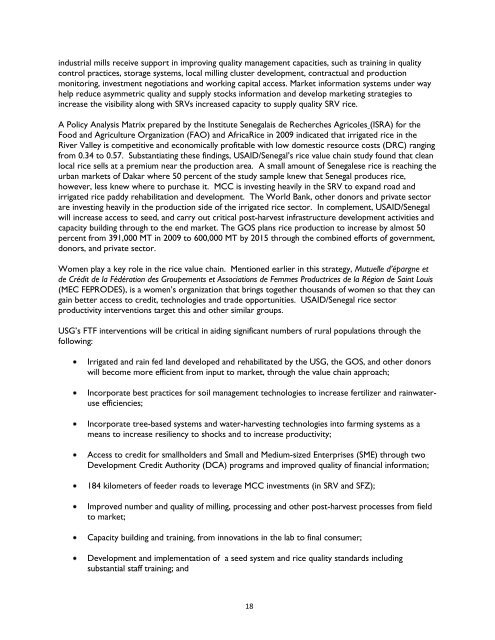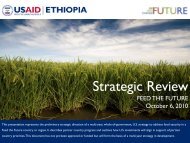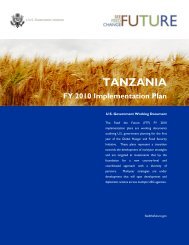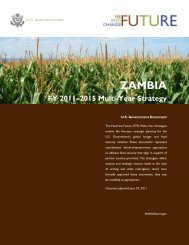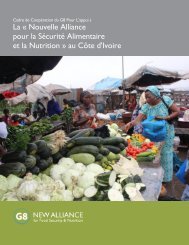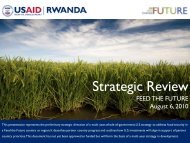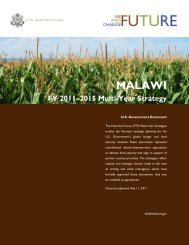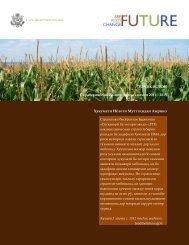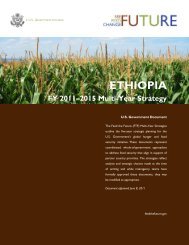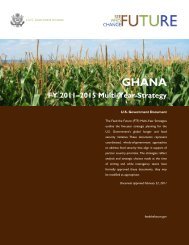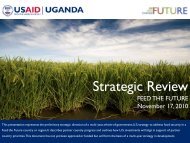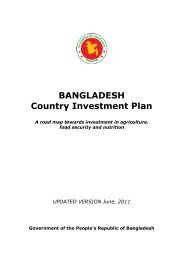Feed the Future Multi-Year Strategy, Senegal, Public
Feed the Future Multi-Year Strategy, Senegal, Public
Feed the Future Multi-Year Strategy, Senegal, Public
Create successful ePaper yourself
Turn your PDF publications into a flip-book with our unique Google optimized e-Paper software.
industrial mills receive support in improving quality management capacities, such as training in quality<br />
control practices, storage systems, local milling cluster development, contractual and production<br />
monitoring, investment negotiations and working capital access. Market information systems under way<br />
help reduce asymmetric quality and supply stocks information and develop marketing strategies to<br />
increase <strong>the</strong> visibility along with SRVs increased capacity to supply quality SRV rice.<br />
A Policy Analysis Matrix prepared by <strong>the</strong> Institute <strong>Senegal</strong>ais de Recherches Agricoles (ISRA) for <strong>the</strong><br />
Food and Agriculture Organization (FAO) and AfricaRice in 2009 indicated that irrigated rice in <strong>the</strong><br />
River Valley is competitive and economically profitable with low domestic resource costs (DRC) ranging<br />
from 0.34 to 0.57. Substantiating <strong>the</strong>se findings, USAID/<strong>Senegal</strong>’s rice value chain study found that clean<br />
local rice sells at a premium near <strong>the</strong> production area. A small amount of <strong>Senegal</strong>ese rice is reaching <strong>the</strong><br />
urban markets of Dakar where 50 percent of <strong>the</strong> study sample knew that <strong>Senegal</strong> produces rice,<br />
however, less knew where to purchase it. MCC is investing heavily in <strong>the</strong> SRV to expand road and<br />
irrigated rice paddy rehabilitation and development. The World Bank, o<strong>the</strong>r donors and private sector<br />
are investing heavily in <strong>the</strong> production side of <strong>the</strong> irrigated rice sector. In complement, USAID/<strong>Senegal</strong><br />
will increase access to seed, and carry out critical post-harvest infrastructure development activities and<br />
capacity building through to <strong>the</strong> end market. The GOS plans rice production to increase by almost 50<br />
percent from 391,000 MT in 2009 to 600,000 MT by 2015 through <strong>the</strong> combined efforts of government,<br />
donors, and private sector.<br />
Women play a key role in <strong>the</strong> rice value chain. Mentioned earlier in this strategy, Mutuelle d’épargne et<br />
de Crédit de la Fédération des Groupements et Associations de Femmes Productrices de la Région de Saint Louis<br />
(MEC FEPRODES), is a women’s organization that brings toge<strong>the</strong>r thousands of women so that <strong>the</strong>y can<br />
gain better access to credit, technologies and trade opportunities. USAID/<strong>Senegal</strong> rice sector<br />
productivity interventions target this and o<strong>the</strong>r similar groups.<br />
USG’s FTF interventions will be critical in aiding significant numbers of rural populations through <strong>the</strong><br />
following:<br />
Irrigated and rain fed land developed and rehabilitated by <strong>the</strong> USG, <strong>the</strong> GOS, and o<strong>the</strong>r donors<br />
will become more efficient from input to market, through <strong>the</strong> value chain approach;<br />
Incorporate best practices for soil management technologies to increase fertilizer and rainwateruse<br />
efficiencies;<br />
Incorporate tree-based systems and water-harvesting technologies into farming systems as a<br />
means to increase resiliency to shocks and to increase productivity;<br />
Access to credit for smallholders and Small and Medium-sized Enterprises (SME) through two<br />
Development Credit Authority (DCA) programs and improved quality of financial information;<br />
184 kilometers of feeder roads to leverage MCC investments (in SRV and SFZ);<br />
Improved number and quality of milling, processing and o<strong>the</strong>r post-harvest processes from field<br />
to market;<br />
Capacity building and training, from innovations in <strong>the</strong> lab to final consumer;<br />
Development and implementation of a seed system and rice quality standards including<br />
substantial staff training; and<br />
18


